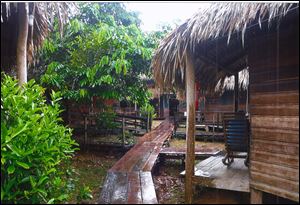
Amazon Jungle in Brazil inspires awe, respect
3/30/2014
Gero Mesquita's Ararinha Jungle Hotel lodge in the Amazon in Brazil is about 100 miles from the city of Manaus. Guests can choose from individual huts or beds or hammocks in a communal sleeping area above the lodge dining room.
MANAUS, Brazil — The Amazon guide raised his hand in the steaming forest and looked at me at the end of a line of six hikers.
“Do you want a machete, Jeremy?” said the guide, Shane Zammette. “Jaguars always attack from the rear.”
It was a moment that brought home the reality of the paradise around us. Amid the tangle of tropical plants and colorful birds, there were also jaguars, poisonous spiders, termite mounds, and caimans lunging into waters infested with piranha. Human visitors must take care.
I quickly learned it’s essential to survey a shoreline before leaping to land a canoe because you might step on something dangerous. I also found myself watching my every movement as I cleared my way along forest paths. By shifting a branch or vine, I could have found myself clutching a spider or a snake. Any unthinking move could prove fatal.
With those lessons in mind, visiting the Amazon is an experience that dispels myths but also brings respect and awe for the largest rainforest on the planet. Indeed, say guides, much of what draws people to the Amazon is the chance to venture into one of the world’s great unknowns.
Our group stayed at a lodge operated by Amazon Gero Tours, one of a number of companies operating from Manaus, a city of 2 million people. In addition to being a gateway for Amazon tourism in Brazil, Manaus is also one of the country’s 12 host cities for the World Cup soccer games taking place June 12-July 13.
Manaus is situated at the confluence of two rivers, the Rio Negro and the Solimoes (the upper Amazon) River. The Negro’s waters are brown, while those of the Solimoes are whitish, and the point where they flow together is easily discernable. As we set off on the first leg of our journey to a jungle lodge, our speedboat slowed so we could see our hands move between the two waters’ colors and feel the difference in temperature of the Negro coming overland while the cooler Solimoes flows from the Andes mountain range.
Landing on the other side 15 minutes later, we traversed a ramshackle dock and dodged food hawkers under the watchful eyes of dozens of vultures sunning themselves on the beach. Trudging up a red-earth bank, we made our way to vans idling in a town seemingly carved from a South American version of the Old West and drove for 90 minutes to a muddy dock.
Here in an afternoon downpour, we deposited our bags into motorized canoes and set off for the lodge through a maze of waterways used as roads by the region’s residents.
At the lodge, Gero Mesquita’s Ararinha Jungle Hotel, guests are given the choice of private huts or accommodation upstairs in the main lodge in hammocks or beds — mosquito netting provided. Once settled in, it’s off piranha fishing with beef used to bait hooks under the guidance of Zammette, a Guyanese transplant to Brazil.
“Every time I come out here, I see something new,” Zammette said. “It gets better and better.”
As our days progressed, hikes and canoe trips uncovered caimans (South America’s alligators) lurking on banks, monkeys howling in the trees, snakes waiting to drop on unsuspecting prey, and colorful birds erupting from trees along the lagoons and rivers.
Indeed, I almost jumped on a 10-foot caiman while landing a canoe to look for sloths.
A day earlier, we almost tipped when we hit something in the water, the canoe rising up and leaning heavily. The shore was 40 feet away through piranha-filled waters. The four of us each admitted we were terrified, grateful to be alive.
“Some people get scared,” Zammette said. “They’re scared of almost everything. As we continue everyday doing our tours, it helps them conquer their fears.”
Zammette said the biggest thrill people have, should they dare, is spending a night sleeping in the jungle. Hammocks are slung between posts among trees and food is cooked over an open fire.
I didn’t sleep much as the night was filled with the screams of birds, howls of monkeys, chirps of crickets, and croaks of frogs.
Indeed, a visit to the Amazon is a trip into the soul of Mother Nature, magnificent and deadly. It is a spiritual experience, not just something to be checked off a bucket list.
If You Go...
MANAUS, BRAZIL: Gateway to Amazon tourism reachable by plane or boat. Do not accept offers for tours from Manaus airport touts; best to research tour companies beforehand.
VISAS: Brazil requires visas from citizens of many foreign countries to be obtained before arrival. Check requirements with a consulate in your country of origin.
HEALTH AND SAFETY: If you’re visiting the Amazon, consult with a physician about health precautions. You may want vaccines for hepatitis, yellow fever and typhoid; you may want to take prophylactic medication to guard against malaria; and you may want to bring anti-diarrhea medication.
Avoid tap water, including in ice cubes and for brushing teeth. Take insect repellent, sunscreen and rain ponchos. Use mosquito netting when you sleep and hang up your shoes at night to keep creatures out — give them a good smack before you put them on.